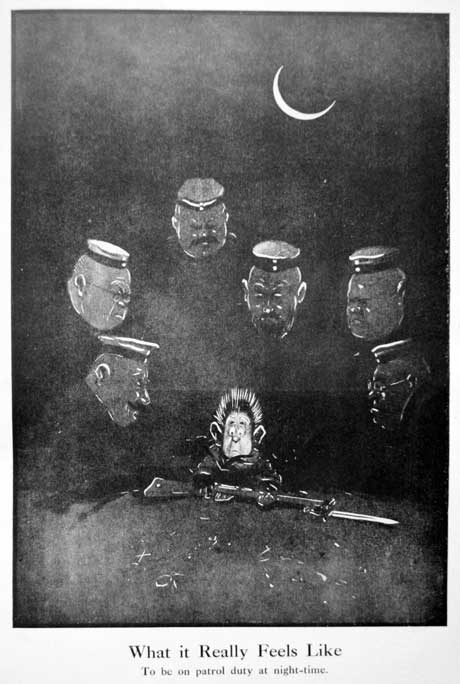141 Days: The Battle of
the SommeNo Manís Land
In the book Songs and Slang of the British Soldier: 1914-1918,
published in 1931, ďNo Manís LandĒ is described as ďa strangely romantic
name for the area between the front line trenches of the British and
German armies, held by neither, but patrolled, at night, by both.Ē
No Manís Land was a terrible place; a piece of ground sometimes only a
few metres wide. The ground would be turned up and cratered by the
constant bombardment of shells from both sides. The shattered remains of
trees mixed with wooden and iron picquets (stakes) between which barbed
wire was strung. The smell of death was all around, combined with the
smell of gun powder and maybe even poison gas which had sunk to the
bottom of the craters.
Worse still, there could be the disturbed graves and cemeteries of
soldiers killed in previous battles, but unable to rest in peace as more
shells ripped the ground apart.
It was not a place to be, in daylight, but it was the only way to reach
the enemy. German soldiers had easily picked out the areas where the
British barbed wire had been cut in preparation for the attacks of the
Somme. They could easily train their Maxim machine guns on to these
positions and cut down advancing troops, with unbelievable ease and
devastation.
At night time No Manís Land was a different place. Both sides sent out
patrols, to listen for the enemy and obtain what ever intelligence they
could. They may even be a raiding party sent to capture enemy soldiers
who could be interrogated. On a dark night it was really dark, on a
night with a full moon it could be far too light! Both sides would fire
flares from Very pistols illuminating, the ghostly shapes of soldiers
patrolling or working for a few minutes.
Working parties operated almost on a nightly basis in No Manís Land.
Some of these men were killed and wounded by enemy fire. Barbed wire
defences had to be laid out, repaired and renewed, as shells could
easily destroy the effectiveness of the wire. Barbed wire also had to be
cut and removed, in preparation for an attack, to permit our soldiers
easy passage to the German lines. Special path-finder patrols would go
out at night and tape Ė or mark out Ė a route to be followed by the
attacking troops.
No Manís Land was the worst place a soldier could be. It was far worse
than a trench, which offered a good amount of protection from enemy
fire. No Manís Land was the killing zone, even on a quiet night, when
little was happening. A soldier could meet his end whilst carrying out
some mundane manual duty, with nothing more threatening than a pick or
shovel.
No Manís Land could be peaceful too. Soldiers like Private William
Hodgson, of the Kingís Own, could sit and listen to a sky lark singing
high above the ground, as if all was normal and the war was a thousand
miles away.

Next: Working Parties
Supported by the Sir John Fisher Foundation and the Army Museums
Ogilby Trust
© Images are copyright, Trustees of the King's Own Royal Regiment Museum.
You must seek permission prior to
publication of any of our images.
Only a proportion of our collections
are on display at anyone time. Certain items are on loan for display
in other institutions. An appointment is required to consult any of
our collections which are held in store.


